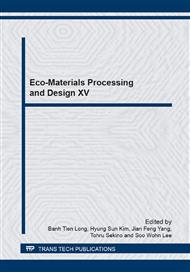p.149
p.153
p.157
p.161
p.165
p.169
p.173
p.179
p.183
Application of Low Voltage in Quantitative Analysis by Energy Dispersive Spectrum (EDS)
Abstract:
By scanning electron microscope equipped (SEM) with energy dispersive spectroscopy (EDS) accessory, analysis can be performed simultaneously in the samples’ micromorphology observation and micro composition test. At present, EDS analysis is generally used high acceleration voltage, and the diffusion range of the incident electrons in sample is 3-5 μm. Therefore, the minimum area for the component analysis is several micrometers. The diffusion range of incident electrons can be reduced by reducing the acceleration voltage, and as a result, the nanometer-scale composition analysis in SEM can be achieved. Based on Monte Carlo simulation method, the incident electrons practical effect range can be estimated. While the acceleration voltage is reduced, X-ray yield rates of the B, C, N, O and other light elements will be increased. Thereby the measuring precision of EDS quantitative analysis of light elements can be improved.
Info:
Periodical:
Pages:
165-168
Citation:
Online since:
October 2014
Authors:
Price:
Сopyright:
© 2015 Trans Tech Publications Ltd. All Rights Reserved
Share:
Citation:


